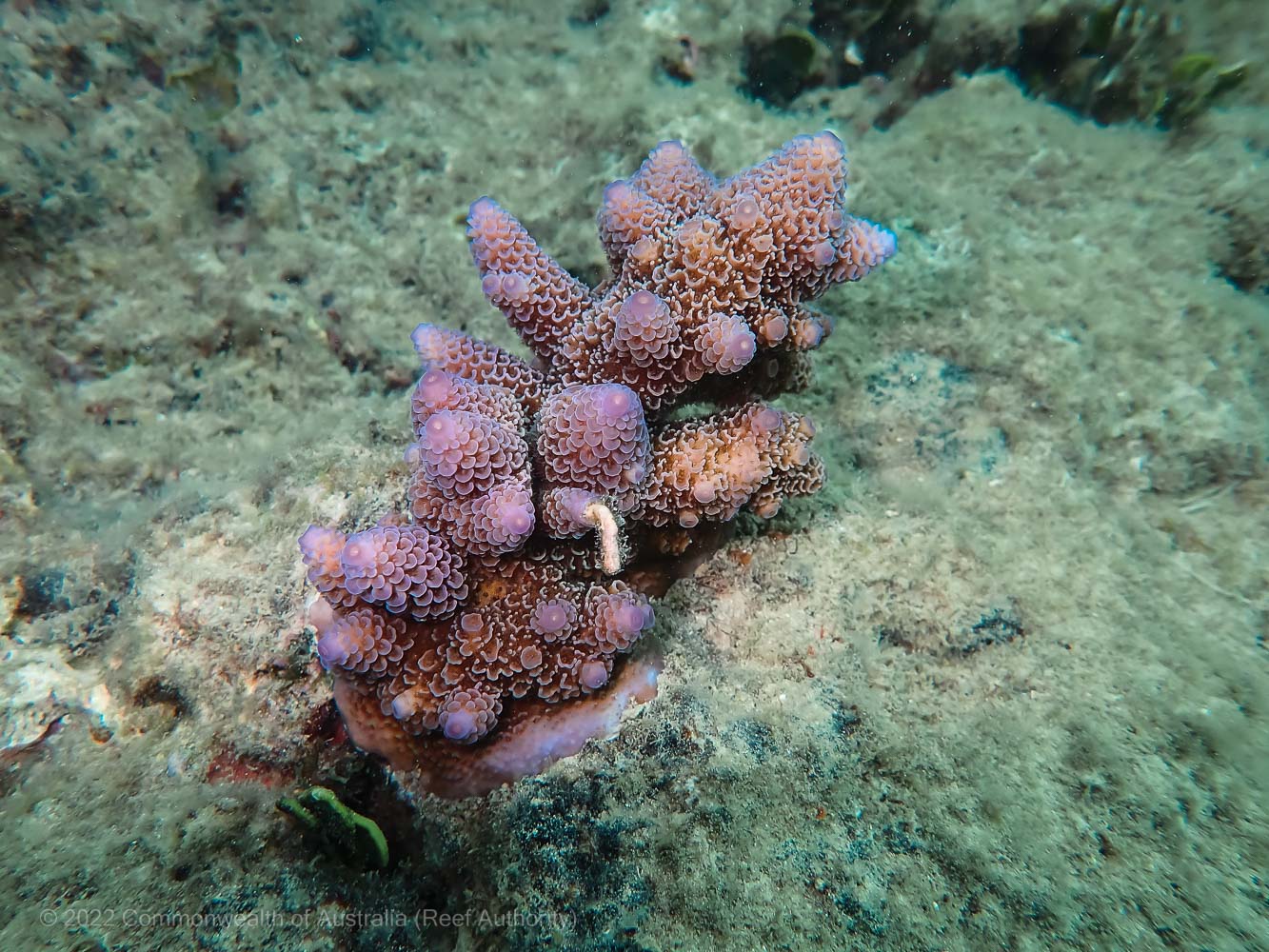Located 27 kilometres from Cairns in the Great Barrier Reef Marine Park, Green Island is the site of an innovative five-year reef regeneration trial that launched in November 2020.
Like many coral reefs, Green Island’s reef is showing signs of impact from accumulating environmental stressors, including crown-of-thorns starfish, cyclones and, most recently, coral bleaching.
- The Green Island reef rehabilitation project used:
- a total of 2675 coral fragments,
- comprised of 2450 live fragments and
- 225 dead fragments.
- Approximately 2250 loose, live coral fragments were attached by hand to 165 interlocked hexagonal, sand-coated metal frames called ‘MARRS reef stars’.
- The remaining 200 live coral fragments are connected to the hard substrate using Coralclips® developed through the Coral Nurture Program.
- The 225 dead coral fragments were collected and used alongside the live coral fragments on the MARRS reef stars, as part of a study trialling biodegradable cable ties.
This direct rehabilitation project is a joint initiative between the Great Barrier Reef Marine Park Authority, Queensland Parks and Wildlife Service, Mars Incorporated, Quicksilver Cruises and Big Cat Green Island Cruises, the Coral Nurture Program and Gunggandji Traditional Owners.
- This project will run over five years and involve ongoing and regular site management and detailed monitoring every six months:
- The project included the installation of a total of 165 reef stars and 200 Coralclip® devices with the key objective of improving coral cover through an area of approximately 200m² of unstable coral rubble and coral rock.
- A total of approximately 2675 coral fragments were used. The fragments came from pieces of coral found lying loose on the seabed (likely broken off by rough weather, large fish or other physical impacts) where they were unlikely to survive.
- A trial of fully biodegradable cable ties is also underway, using 225 dead coral fragments. These biodegradable cable ties are made of potato starch and are being tested to see if they are suitable for use in future reef rehabilitation projects.
- The project has allowed local operators, private companies, the Gunggandji Traditional Owners and marine park management agencies to work together in a way that is encouraged through the Reef Authority’s Great Barrier Reef Blueprint for Climate Resilience and Adaptation (Blueprint 2030), encouraging new ideas and partnerships to improve Reef health.
- The site is in only 4-6m of water and available for both confident snorkelers and scuba divers to visit and see how these techniques can improve hard coral cover in ‘high-value’ sites.
- Why Green Island?
- The specific project site was chosen for rehabilitation because of the low coral cover and loose coral rubble (broken coral skeletons that accumulate in ‘fields’), making it hard for new larval corals to settle and grow safely.
- Adjacent hard coral cover (on coral rock) was also lower because of past impacts of crown-of-thorns starfish, coral bleaching and cyclones.
Two rehabilitation tools were used at the site; MARRS reef stars and Coralclips®.
Mars Assisted Reef Restoration System (MARRS) reef stars
Reef stars are hexagonal metal frames that can be placed on the sea bed. In areas of loose coral rubble, they provide a stable platform that can be used to attach live coral fragments too.
These coral fragments can then continue to grow and eventually completely cover the reef star structure. They were originally developed by Mars Incorporated for use in Indonesia to rehabilitate reefs impacted by blast-fishing.
Coralclip®
A Coralclip® is a small spring-loaded clip made of stainless steel attached to hard coral rock via masonry nails. A suitable fragment of live coral can then be held in place under the clip where it continues to grow. The Coralclip® was developed by the Coral Nurture Program which is a consortium of Reef tourism operators and University of Technology Sydney researchers.
August 2025
From Phil Coulthard (Environmental and Compliance Manager, Quicksilver Group):
Great Adventures now offers a daily Reef Biosearch Marine Biologist presentation at the Green Island information counter. The reef stars are a key focus, sparking conversations among visitors and resort guests. One reef star is even on display to show the structure, explain the project and highlight the overall importance of reef rehabilitation and intervention.
The rehabilitation site’s accessibility makes it ideal for guided experiences. Afternoon snorkel and dive tours frequently include the reef stars site. Focus is not only on the ecological value of the rehabilitation effort but also on important partnerships and collaboration among governing agencies, tourism operators and Traditional Owners.
Projects like this one on Green Island go beyond improving reef resilience, they enhance visitors’ experiences and promote sustainability on a global scale.
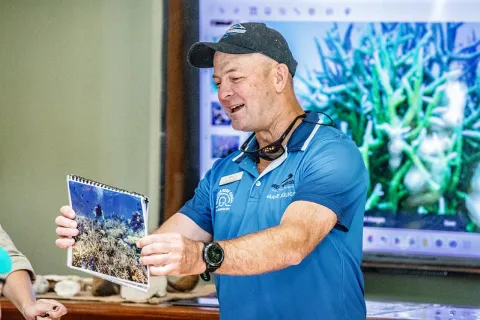

Learn more about key project partners:
Mars Coral Reef Restoration.
GBR Biology (Experience Co.)
December 2024
During 4–5 December 2024, the 4-year monitoring of the Green Island reef rehabilitation site was completed.
Most coral had recovered from the earlier 2024 bleaching event. Estimates suggested up to 20% mortality, but many stressed corals had rebounded.
All monitoring data from the past four years is now being collated to assess the success and viability of reef rehabilitation projects.
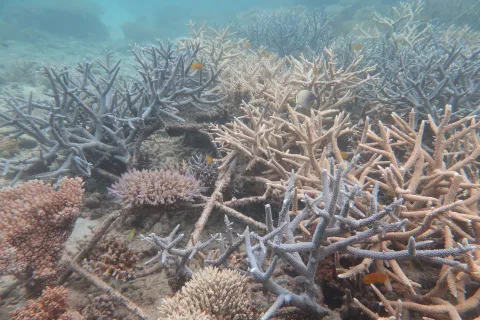
Mid 2024
Observations by project partners Mars Sustainable Solutions and Quicksilver Cruises continued after Cyclone Jasper to assess ongoing threats.
- April 2024: Coral bleaching and COTS detected, and COTS removed.
- May 2024 – Coral colour began to return as symbiotic algae (zooxanthellae) returned to the corals.
- July 2024: Mortality ranged from 5–20% mortality, mainly affecting table corals. Most corals show signs of recovering.

January 2024
Cyclone Jasper crossed the east coast of Australia to the north of Cairns on 13 December 2023. It caused record flooding, discharging approximately 20,000 GL of freshwater into the coastal marine environment, leading to localised freshwater coral bleaching.
A new set of site surveys at the Green Island rehabilitation site was considered appropriate to allow:
- A comparison with the data recently collected in December 2023 (prior to Cyclone Jasper).
- To conduct a general survey of the area for any impacts from the cyclone and the above average sea temperatures (approximately 1°C above the long-term average).
11 January 2024 surveys
- Conducted by the Reef Authority and Queensland Park and Wildlife Service, along with project partners Mars Sustainable Solutions and Quicksilver Cruises
- 150 line transect photo-quadrats in the same format as the December 2023 surveys, taken across the three sites (experimental, positive control and negative control).
- GoPro video transects (two at each site) were also taken along two 25 m transect lines. No widespread impacts such as significant coral damage, rubble movement or bleaching were observed. Minor damage was noted nearby.
The rehabilitation site remained largely intact. Future threats include elevated sea temperatures and COTS.

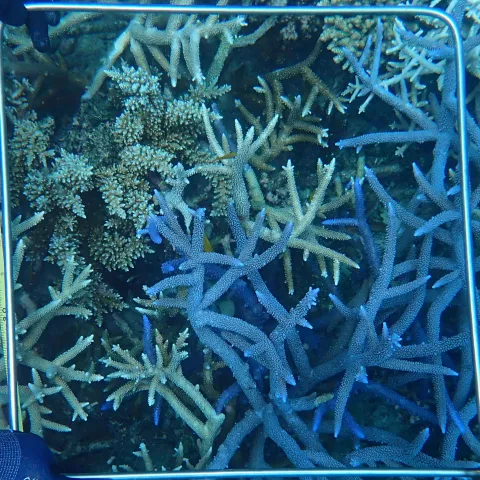
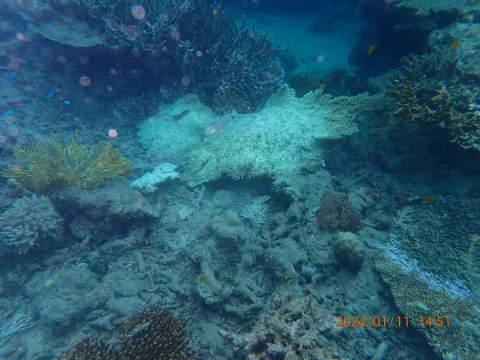
December 2023
During the third-year monitoring (5–6 December 2023), a spike in COTS was recorded. The starfish were collected, measured and humanely removed by Quicksilver staff as part of the Reef Authority’s Tourism Reef Protection Initiative (TRPI).
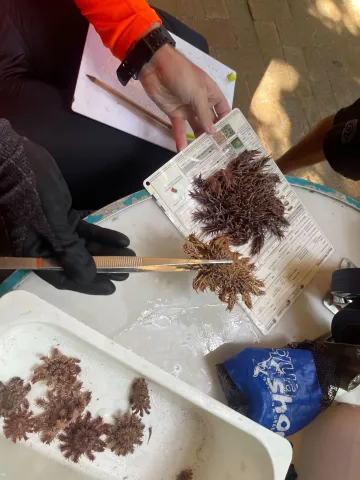
December 2022
Two years after installation, coral size and fish diversity at the Green Island reef rehabilitation site continued to increase. Monitoring was undertaken on 7–8 December 2022 and included:
- Coral cover and health
- Presence/absence of other benthic organisms (including COTS)
- Fish biomass and diversity
Three sites were monitored: experimental (rehabilitation), positive control and negative control. Comparing these sites highlights the progress achieved through reef rehabilitation.
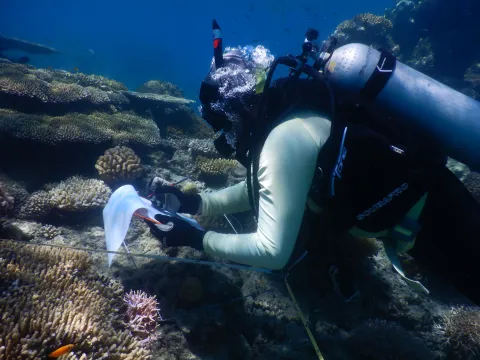

June 2022
The 18-month ecological monitoring of the Green Island reef rehabilitation site was undertaken on 14-15 June 2022. The Reef Authority joined Queensland Parks and Wildlife Service colleagues and project partners Mars Sustainable Solutions, Quicksilver Cruises, and Experience Co. in two days of diving on not-so-settled seas.
Data collected included coral cover and health, presence/absence of other benthic organisms (including COTS), and fish biomass/diversity across three monitored plots (25m x 15m).
- While this data is yet to be analysed, it was visually obvious that the site continues to improve. Some of the installed reef-star structures are now hard to see under a thick growth of coral.
- Since the installation, there has been some coral mortality (data collected at 12 months indicated 12% mortality).
- This was expected and most of it occurred in the first few months after the reef stars were installed.
- Since then, the site has experienced unfavourable impacts such as cyclonic conditions from cyclone Kimi in January 2021 and coral bleaching in early 2022. Monitoring will continue until 2027, with results improving our understanding of localised, small-scale rehabilitation efforts.
November 2021
- When: 17-19 November 2021 - End of the first year
- Where: Green Island - rehabilitation site
Increases in coral growth and fish diversity are now visually obvious. Individual corals continue to grow over the reef stars and, in most cases, are firmly attached. Data is yet to be fully analysed.
Fully analysed data, collected in May 2021 monitoring, shows coral cover has increased from 15% to almost 25% at the rehabilitation site. This trend is expected to continue with the analysis of the latest data. The number of fish species per monitored transect has risen from 24 per monitoring transect prior to installation to 32 per transect in May. It is likely this has further increased along with total fish numbers.
Movement of reef-stars: The biodegradable cable-ties (made of potato starch) trials that commenced in November 2020 are now complete. Unfortunately, the trial has proved these ties unsuitable, with high failure rates pertaining to the tie's complete breakage, inability to secure coral fragments and coral showing a reluctance to grow over them. With no further trials (of different biodegradable ties) proposed for this site, the 15 reef stars used in the trial were moved across to the main rehabilitation site.
This relocation was undertaken in the same week as the monitoring work and went smoothly. The 15 reef stars were moved quickly (by vessel) from the experimental site to the rehabilitation site with the help of team members on snorkels. The following day these reef stars were firmly attached to the rest of the rehabilitation site, and new coral fragments were attached.
Signs of the COTS: the COTS control program is reporting that the number of these coral-eating starfish appears to be increasing at Green Island reef and other nearby reefs. Increased monitoring and active control will be undertaken if it is required to protect the growing coral at this high-value site.
Visitation and expanded use: the rehabilitation site has been made available to other research projects to help us learn more about its developing and changing ecological makeup. This has included photogrammetry (3D photography to help monitor change) and more detailed fish surveys.
Project partners and stakeholders from the tourism industry state high visitor interest in the site, becoming a feature of the snorkel safaris for Green Island. Unfortunately, travel restrictions for much of the past year have meant that visits to the site have dropped significantly. We are optimistic that many snorkelers and divers will soon be able to frequent the site.
In summary: ‘It looks amazing!’ Is the most common reaction by all involved when they see the site. With the rubble site now covered with healthy, growing coral and increasing fish diversity in 12 months, we hope that, given the right conditions, coral reefs can flourish into the future.
February 2021
The first full round of environmental monitoring was conducted in early February 2021. This included surveys of fish populations and coral cover, recruitment and health. While this data has not been fully analysed, there are indications fish species are beginning to populate their new habitat and coral cover has increased.
There have been approximately 90.3 per cent coral survivorship of the coral fragments attached to the reef stars, with most coral showing signs of new growth and beginning to attach firmly to the reef stars.
While a 9.7 per cent mortality is higher than experienced at other similar projects, this was not unexpected at this site due to its inshore location. Poorer water quality due to higher turbidity and nutrients at Green Island is likely having some effect.
November 2020
Initial installation of a total of 2675 loose coral fragments using 165 MARRS reef stars and 200 Coralclip® devices.
- It is important to note that reef stewardship and intervention projects like this Green Island Reef Rehabilitation project are:
- Not a replacement for major global action to address greenhouse gas emissions and the impacts of climate change on coral reefs around the world.
- Not a replacement for continued efforts to address other impacts on the Great Barrier Reef. See the Great Barrier Reef Outlook Report 2019.
- Designed to assist natural recovery processes in small areas of reef that have been impacted by environmental stressors.
- Potentially very useful to improve the condition of ‘high-value’ areas of reef (e.g. popular tourist sites or an area with identified specific high ecological value) or repair areas of reef damaged by vessel collisions.
- Examples of partnerships and stewardship actions that may become more broadly used across the Great Barrier Reef.
- Designed to include technical and field-based training for stakeholders involved and ongoing monitoring and reporting to help improve scientific understanding and measure levels of success.
Traditional Owners
Thousands of years ago, before sea level rise transformed Green Island from coastal plains to a coral reef, the area was home to the Gunggandji Traditional Owners. Green Island’s traditional name is Wunyami.
Tourism
Green Island’s proximity to Cairns has seen the island play a major part in the development of the modern reef tourism industry over the past 100 years, showcasing the beauty of the Great Barrier Reef to the world.





